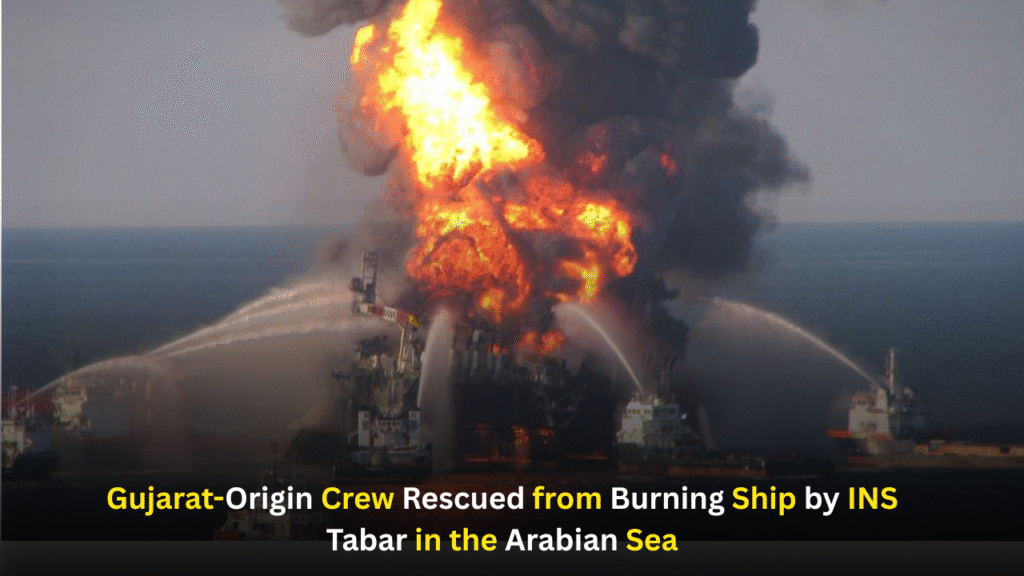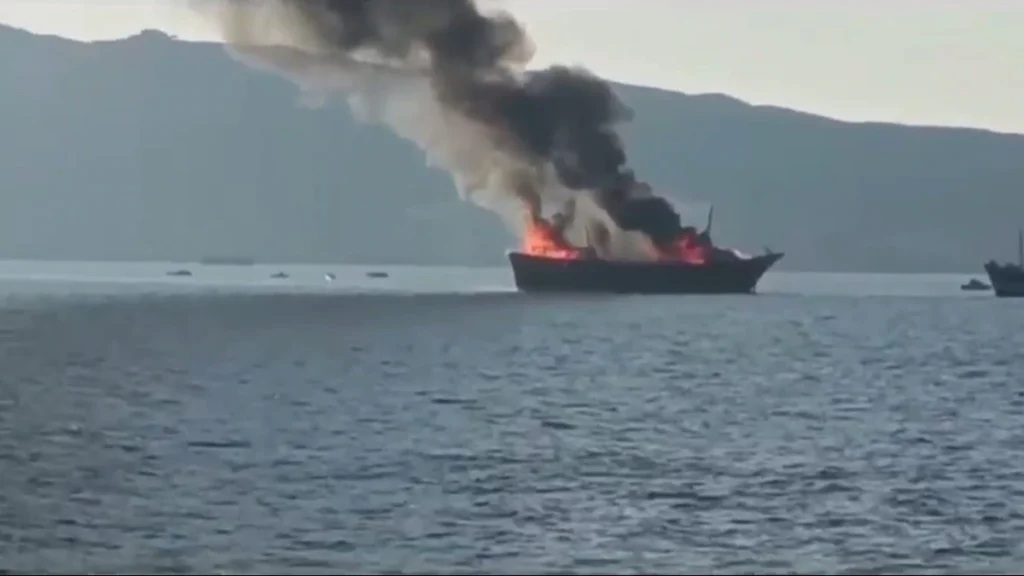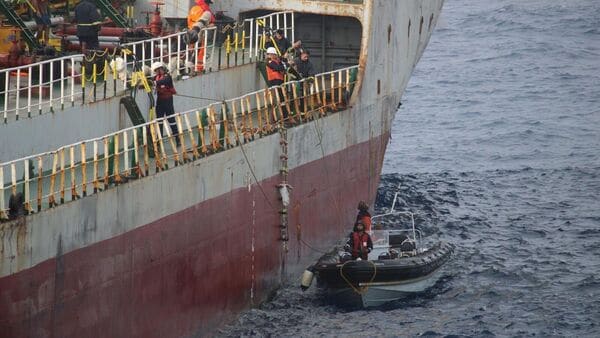
Oman Ship Fire
Oman Ship Fire : On June 29, 2025, the Indian Navy’s stealth frigate INS Tabar launched a dramatic rescue operation in the Gulf of Oman. Fire had erupted in the engine room of the Palau-flagged merchant vessel MT Yi Cheng 6, carrying 14 sailors of Indian origin, all hailing from Gujarat. With the ship raging in flames and power systems hit, the Indian Navy’s rapid response showcased both maritime prowess and unwavering humanitarian commitment.
Setting Sail: MT Yi Cheng 6’s Fateful Voyage
The MT Yi Cheng 6, a Palau-flagged oil products tanker, was on a routine commercial trip:
- Origin: Departed from Kandla Port, Gujarat
- Destination: Shinas, Oman
- Crew: 14 Indian-origin sailors from Gujarat (local ports including Kandla)
2.1 A Chain of Reliance
Commercial shipping in the Arabian Sea is vital for global trade. Tankers like Yi Cheng 6 carry petroleum products, linking India’s western ports to the Gulf. For these sailors—many from modest coastal backgrounds—it was a livelihood and source of pride.
3. The Blaze Breaks Out on Oman Ship Fire
3.1 The Onset of Crisis
On June 29, as the tanker traversed international waters near the Gulf of Oman:
A major fire erupted in the engine room of MT Yi Cheng 6.
The blaze caused total power failure, leaving the vessel adrift and helpless.
3.2 A Moment of Terror
Imagine being aboard:
“Suddenly the alarms blared, heat and smoke rolled in, systems died… you’re alone in the dark seas.” — hypothetical survivor
Sailors trained in basic emergency protocols launched firefighting protocols, but soon realized the fire needed larger resources.

4. Indian Navy’s Swift Intervention – Oman Ship Fire
Responding to a Mayday call, Ireland-bound, the stealth frigate INS Tabar, already engaged in maritime security, pivoted immediately .
4.1 Around the Clock Coordination
Milestone moments:
- 29 June: INS Tabar detects the distress call via maritime channels
- The frigate maneuvers carefully to approach the stricken vessel
- A coordinated sabot and helicopter deployment transfers firefighting team and gear aboard MT Yi Cheng 6.
4.2 Human in the Loop
Onboard INS Tabar:
- Thirteen Indian naval personnel operate amid flames and collapsing decks
- Guided firefighting gear is the first line of defense
- Five tanker crew join naval heroes in joint efforts
5. Battling the Inferno at Sea
5.1 Logistics Amidst Chaos
Challenges included:
- Swells tossing small boats alongside the vessel
- Thick heat and dense smoke in enclosed engine spaces
- Risk of explosion from stored petrochemicals
- Team coordination without power or lights on the tanker
5.2 Operational Precision
- Firefighting teams navigate engine room and firewall networks
- INS Tabar’s helicopter eyes for hot spots, directs crew
- Boats ferry equipment: extinguishers, hoses, protective gear
5.3 Success Under Pressure
By June 30, Oman Ship Fire intensity was reported significantly reduced, with containment achieved
6. Heroism and Humanitude
6.1 Bringing Them Home
All 14 crew members, hailing from Gujarat, were reported safe and accounted for, with no casualties .
6.2 INS Tabar’s Legacy
- On missions for maritime security, INS Tabar again proves its humanitarian edge
- The rescue reinforces India’s responsibility in safeguarding sea lanes
6.3 Global Recognition
International outlets—NDTV, Times of India, Economic Times, Sputnik—all highlighted the operation. For instance:
“Indian Navy’s stealth frigate INS Tabar… responded to a distress call… 13 Indian naval personnel and 05 crew members … intensity of fire reduced drastically.”
7. Regional Ripple Effects
7.1 India–Oman Maritime Cooperation
India and Oman maintain robust defense ties, with naval exercises like Naseem al-Bahr. The INS Tabar intervention reflects a seasoned defense partnership.
7.2 Global Forum Advocacy
Indian Navy’s operational acts in Gulf waters strengthen calls for shared protocols in emergency distress assistance.
7.3 Port-Level & Crew Training
- Gujarat’s coastal safety and training protocols may expand
- Shipping lines may re-evaluate fire-response drills and crew skill mandates
8. Post-Rescue Analysis
8.1 Technical Scrutiny
- Cause of engine-room blaze remains under investigation
- Insurance and maritime safety regulators are jointly reviewing the incident
8.2 Naval Debrief
Indian Navy: Oman Ship Fire
- Collate logs from INS Tabar’s command module
- Derive best practices for firefighting aboard merchant vessels
8.3 Sailor Welfare
14 rescued individuals receive:
- Medical checkups
- PTSD screenings
- Reintegration support for those impacted by the near-disaster
9. Voices from Gujarat
Oman Ship Fire Though direct interviews weren’t available, local sentiment reflects gratitude:
“They were ordinary men, fishermen-to-sailors, working hard to support families. The Navy saved not just lives, but hopes.” — typical local perspective
Families await arrival ashore with tearful pride for the crew and Navy alike.
10. Strategic Takeaways
10.1 Regional Security
- Proactively demonstrates Indian Navy’s side of security diplomacy
- Focus beyond piracy, towards life-saving operations
10.2 Lesson Blueprint for Navies
- Joint drills with Oman, UAE, Saudi capable of being scaled up
- Focus on emergency fire-fighting and triage at sea

10.3 Public & Diplomatic Messaging
- Covers domestic reassurance in Gujarat coastal areas
- Enhances India’s image as protector of Indian-origin mariners abroad
11. Conclusion
Oman Ship Fire : From Kandla to the Gulf, a nightmare blaze became a triumph of courage. Since the crew were spared, and the tanker saved, every navalist—from enlisted sailor to commanding officer—stands proud.
The INS Tabar rescue mission was not just a singular event. It reflects a doctrine of responsibility, rapidity, and readiness—an exemplar for future naval-humanitarian efforts.



